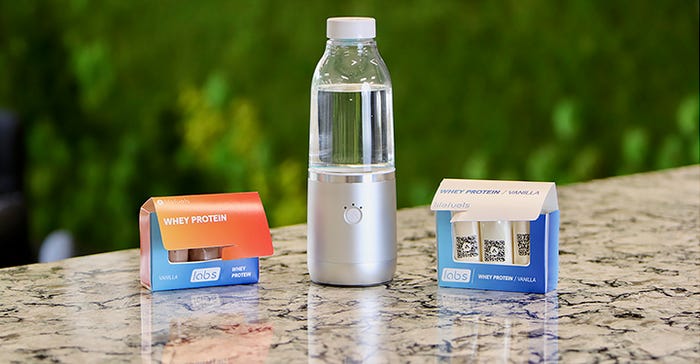LifeFuels’ Smart Bottle system is adding dissolvable film packs printed with an edible-ink QR code.
October 7, 2020
A smart tactic to draw attention for a product roundup of new products for packaging or other markets is to lead with the best or most photogenic development. It’s doubly advantageous when said product is a world’s first of some kind, which is why LifeFuels, “the world's first smart nutrition bottle,” headed the gallery of 8 Unexpected Ways Beverage Packaging Innovates, published June 2020.
In short, the reusable LifeFuels' 16.9oz/500mL smart nutrition bottle turns ordinary water into a beverage with flavor, essential vitamins and nutrients using small bottles of liquid ingredient concentrates called “Pods.” The Pod, which can refill the LifeFuels bottles 30 times, are equipped with a Radio-Frequency Identification (RFID) tag.
Pretty cool, right?
The company will shortly bring an even more sustainable packaging innovation to the platform: Cylindrical-shaped Modules, or Mods, which are powdered ingredients packs made of food-grade film that fully dissolve in water.
A Quick Response (QR) code printed with edible ink on the Mod film connects with the smart nutrition tracking platform via the LifeFuels smartphone app.
The innovative packaging eliminates the need for the usual plastic tubs, scoopers, or single-serving packets typical of the powdered beverage market.
The company is planning to launch with at least two flavors, but more are possible. Mod pricing is also to be determined.
The company’s managers responded to our questions presented in the following highlights.

Left-to-right, LifeFuels’ Mark Lyons, Christine Shearer, and Amanda DiCuffa-McGregor.
Ultra-convenient delivery.
“Our classic Pod package provides exceptional protection, dispense precision, and traceability for liquid concentrates,” says Mark Lyons, VP of engineering. “However, protein supplements are typically found in powder form and demand larger serving sizes. We wanted to find a way to deliver these nutritional products in a convenient form factor while maintaining the same level of consumption tracking within our digital platform.”
A no-mess experience.
“Although the Pod bottles have their sustainability advantages, with dissolvable film, the Mod product has almost no waste when used by the consumer,” says Amanda DiCuffa-McGregor, beverage product manager. “This is because the powder is encased in the film, which dissolves entirely in water. We are also looking into compostable packaging for methods of delivery to ensure sustainability in our in-house supply chain.”
“Protein powder is notoriously messy and difficult to manage on-the-go when you need it most,” adds Lyons. “With this package there is no measuring or spilled powder, and the system maintains an accurate record of nutrients consumed.”
Add, shake, and drink.
“The Module will be added to 450-mL of cool water in a bottle with 500-mL capacity,” explains Beverage Scientist Christine Shearer. “The lid is closed and the bottle shaken 5-10 times to disperse and dissolve the film and the powder. We have found that most consumers shake their protein powder bottles much more vigorously and longer than is actually needed for this process to take place.”

Works akin to the current Pods.
“The Modules are integrated into the LifeFuels system basically the same way as our classic Pods,” explains Nick Mahon, Mobile Software Manager. “The scanned SKU references the ingredients stored in our database, then the app and the Bottle work together to track and report consumption data for the user, giving them insights and visualization into their individual nutrition and hydration data.”
Fast-track development.
“Leveraging R&D work we had done on powders and dissolvable films, we launched a rapid product development effort in July of this year, with plans to begin beta testing in late September,” says Lyons.
The company is launching the Beta testing with consumers this week.
Product and packaging film attributes.
“We researched ingredients and methods for the preparation of different films and experimented in-house and developed a formula that had the flexibility, strength, heat sealability, and dissolvability we were looking for,” says Shearer. “The ingredients were either already in our ingredient pantry, available from our current suppliers, or in a few cases, required some research to find new suppliers. While researching printing on edible film we found that the cake decorating business offers considerable use of edible ink.”
A short video below shows the process for the QR-code-printed film.
General storage considerations.
“We’re asking consumers to store the Modules in a cool, dry place,” says Shearer. “This is a conservative approach since the film has excellent moisture barrier properties. During the Beta test we will continue to learn more about the interaction of the film with the protein powder and the environmental conditions.”
Contract packaged with direct supervision.
“We fill our products at a certified secondary location, with a supporting LifeFuels production team present on site,” says DiCuffa-McGregor. “Additionally, all the machinery used in the Pod and Mod filling processes has been designed and is owned by LifeFuels.”
You May Also Like


